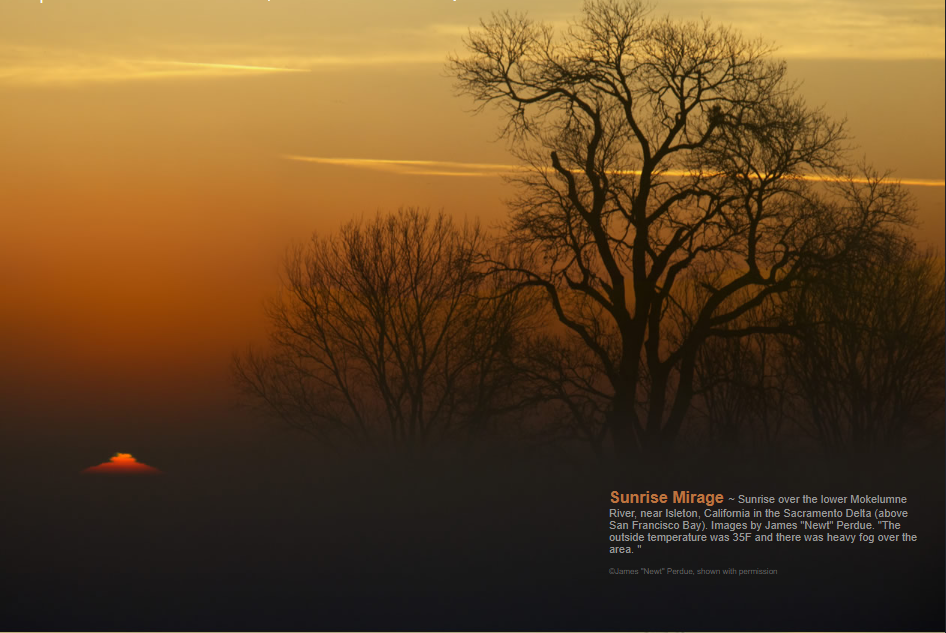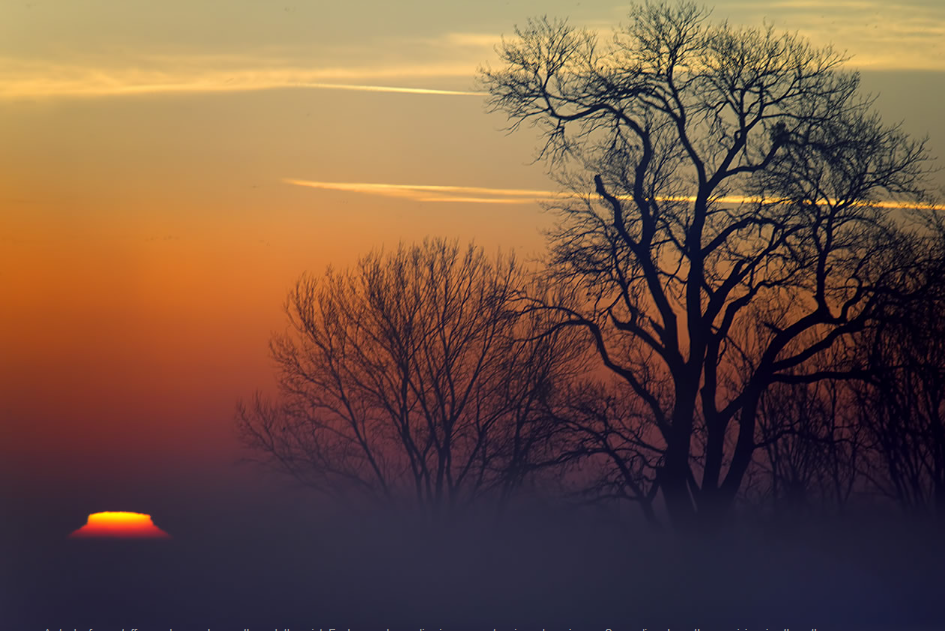OPOD - Mokelumne River Mirage
OPOD - Mokelumne River Mirage: A Spectacular Sunrise Phenomenon
Have you ever witnessed a breathtaking sunrise that seemed almost otherworldly? The Mokelumne River Mirage is one such atmospheric optics phenomenon that captivates the eyes and ignites the imagination. Located near Isleton, California, in the Sacramento Delta, this mirage creates a mesmerizing display as the sun emerges over the lower Mokelumne River. In this article, we will delve into the details of this enchanting spectacle and explore the science behind it.
The Dance of Sun-Stuff Pancakes
As you gaze at the Mokelumne River Mirage, you will notice a stack of sun-stuff pancakes gracefully pushing through the mist. Each pancake represents a separate miraged image of the sun. Some slices exhibit the sun rising, while in others, the image is inverted, giving the illusion of a sinking sun. These mirage slices mark temperature inversion layers, where the typical lapse rate of air cooling with increasing height is replaced by warmer air above cooler air. It is likely that overnight radiation cooling of the surface contributes to the formation of these inversion layers.
A Peek into the Inversion Layers
The inversion layers responsible for the Mokelumne River Mirage can be remarkably narrow and situated close to the ground. These layers create a unique atmospheric condition where warmer air rests above cooler air, defying the usual temperature gradient. As a result, light rays passing through these layers undergo refraction, causing the mirage to form. This optical phenomenon adds an ethereal touch to the already captivating sunrise scene.
Unraveling the Mock-Mirage Type
The Mokelumne River Mirage belongs to the category of mock-mirages, which are known for their intriguing characteristics. While observing a strong mock-mirage, you may be fortunate enough to witness multiple, albeit fleeting, green flashes at and above the topmost pancake. These green flashes occur due to the bending of sunlight as it passes through the atmosphere. The phenomenon is reminiscent of the legendary green flash that occasionally graces the final moments of a sunset over the ocean.
Exploring the Magic of Temperature Inversions
Temperature inversions play a pivotal role in the formation of atmospheric mirages like the one observed at the Mokelumne River. These inversions occur when a layer of warmer air is trapped between two layers of cooler air. As light passes through these temperature gradients, it experiences bending and refraction, resulting in the mirage's enchanting visual effects. The Mokelumne River Mirage serves as a stunning reminder of the intricate interplay between temperature variations and atmospheric optics.
A Closer Look at the Conditions
To witness the Mokelumne River Mirage in all its glory, certain weather conditions need to align. Heavy fog covering the area, as observed in James "Newt" Perdue's images, contributes to the misty backdrop against which the mirage unfolds. Additionally, a temperature inversion layer close to ground level is crucial for the mirage's formation. When these elements come together, nature treats us to a spectacle that transcends our everyday experience of the sunrise.
The Wonders of Atmospheric Optics
The Mokelumne River Mirage exemplifies the wonders of atmospheric optics, showcasing how light interacts with our atmosphere to create mesmerizing visual phenomena. As we delve deeper into the study of these optical marvels, we gain a better understanding of the complex nature of light and its behavior in different atmospheric conditions. Each unique mirage offers a glimpse into the intricacies of our environment and reminds us of the beauty and mysteries that surround us.
Conclusion
The Mokelumne River Mirage stands as a testament to the enchanting allure of atmospheric optics. Its sun-stuff pancakes rising through the mist, accompanied by the occasional green flashes, provide a truly captivating experience. By exploring the science behind temperature inversions and mirages, we gain a deeper appreciation for the intricate interplay between light and our atmosphere. So, next time you find yourself near the Mokelumne River at sunrise, keep an eye out for this extraordinary phenomenon and let yourself be spellbound by its ethereal beauty.

Sunrise Mirage ~ Sunrise over the lower Mokelumne River, near Isleton, California in the Sacramento Delta (above San Francisco Bay). Images by James "Newt" Perdue. "The outside temperature was 35F and there was heavy fog over the area. "
©James "Newt" Perdue, shown with permission

A stack of sun-stuff pancakes pushes up through the mist. Each pancake or slice is a separate miraged sun image. Some slices have the sun rising, in others the image is inverted and the sun is sinking. Each slice marks a temperature inversion layer where the 'normal' lapse rate of air slowly cooling with increasing height is replaced by warmer air above cooler. Overnight radiation cooling of the surface is likely responsible. The inversion layers can be quite narrow and close to ground level.
This is a mock-mirage type of sunrise. Strong mock-mirages can give multiple but very transient green flashes at and above the topmost pancake.

Note: this article has been automatically converted from the old site and may not appear as intended. You can find the original article here.
Reference Atmospheric Optics
If you use any of the definitions, information, or data presented on Atmospheric Optics, please copy the link or reference below to properly credit us as the reference source. Thank you!
-
<a href="https://atoptics.co.uk/blog/opod-mokelumne-river-mirage/">OPOD - Mokelumne River Mirage</a>
-
"OPOD - Mokelumne River Mirage". Atmospheric Optics. Accessed on April 18, 2024. https://atoptics.co.uk/blog/opod-mokelumne-river-mirage/.
-
"OPOD - Mokelumne River Mirage". Atmospheric Optics, https://atoptics.co.uk/blog/opod-mokelumne-river-mirage/. Accessed 18 April, 2024
-
OPOD - Mokelumne River Mirage. Atmospheric Optics. Retrieved from https://atoptics.co.uk/blog/opod-mokelumne-river-mirage/.